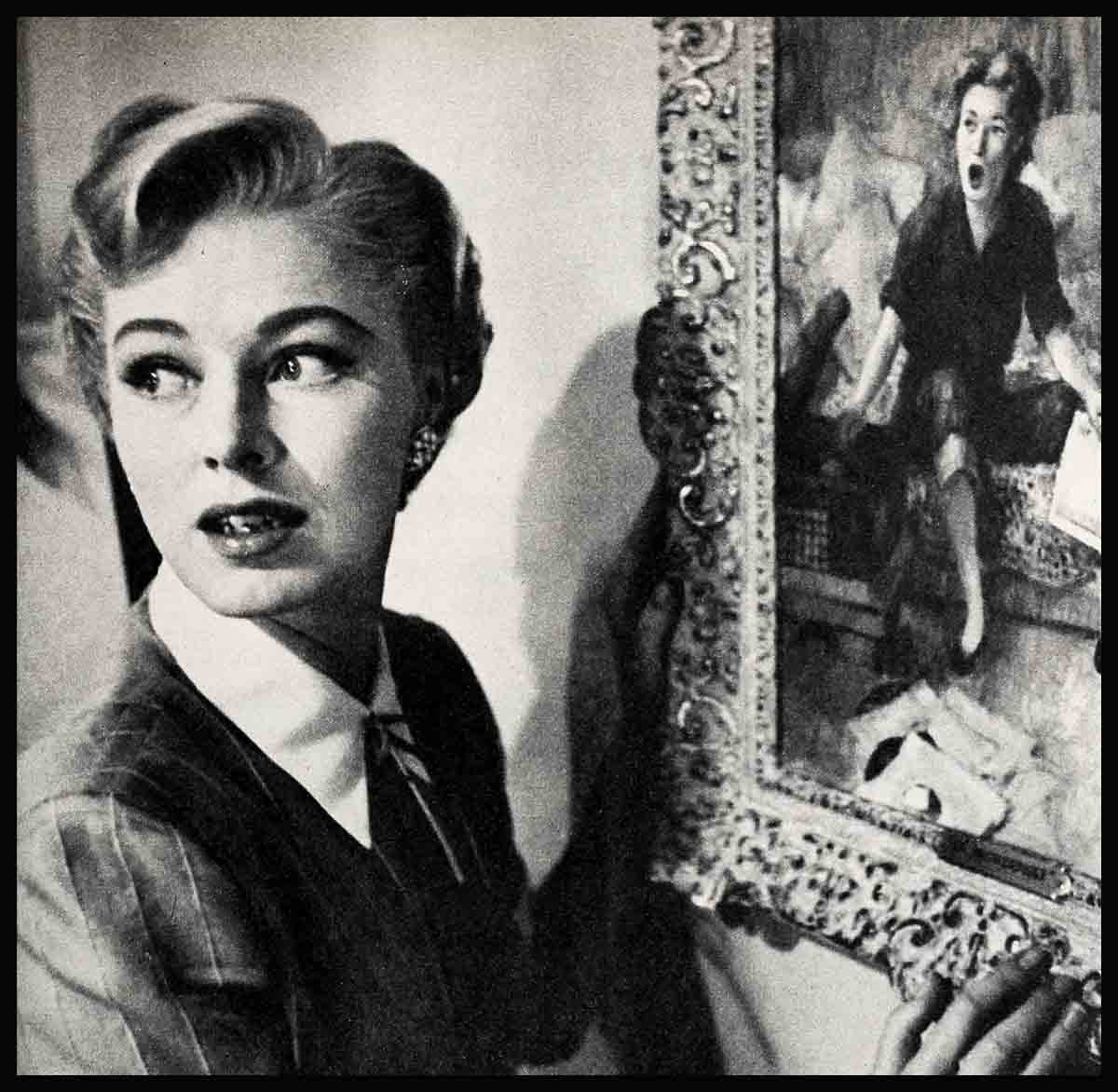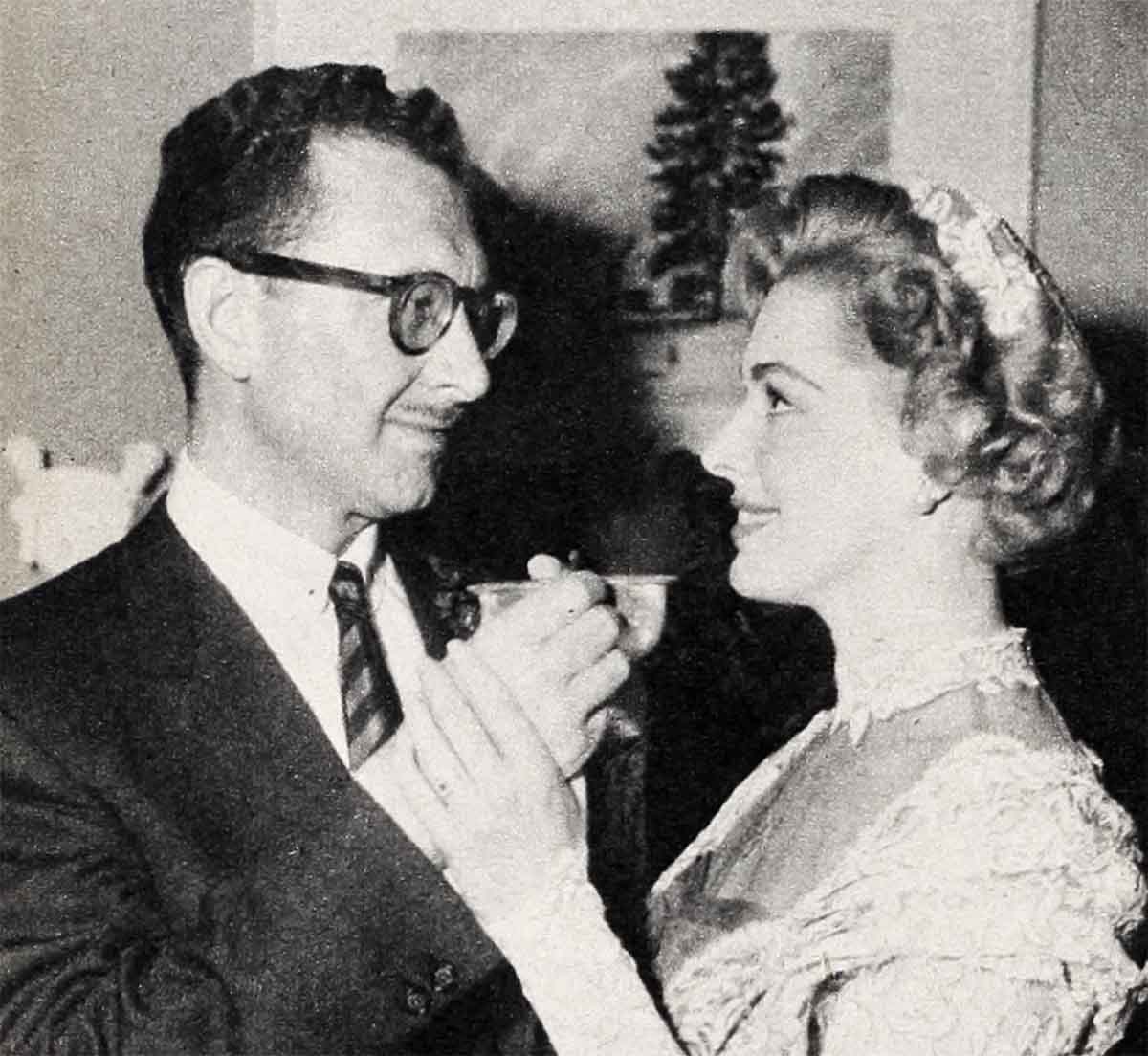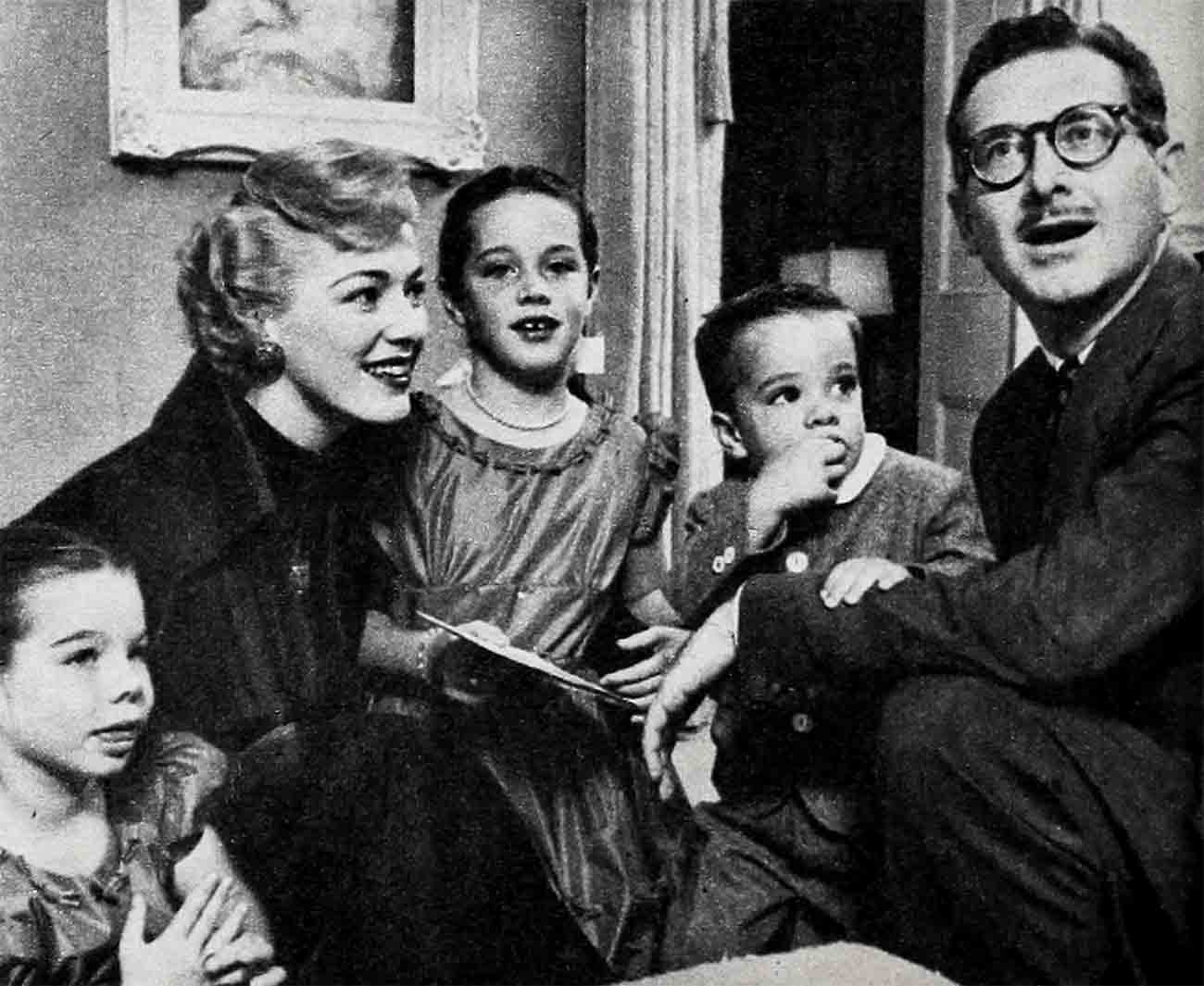
Changeable Lady—Eleanor Parker
Not long ago, Eleanor Parker attended a small dinner party and while entering the room passed the famous William Wyler, who had directed her in one of her most important pictures, “Detective Story.” Smiling up at him, she greeted him warmly, “Hello, Willie, how are you?”
Wyler gave her a startled who-are-you? look, nodded coolly and turned away.
Ten minutes later, after evidently having made inquiries, he was back, contrite and chagrined. “What have you done to yourself, Eleanor?” he begged. “I didn’t know you!”
“Just a different hair-do,” she laughed. “But don’t let it bother you. It happens all the time.”
In 1951, while making “Scaramouche,” Eleanor walked onto the set one day wearing a red wig. “Oh, look at the swell foreign dish!” one of the members of the cast exclaimed. “She’d be wonderful for the lead in this picture. I bet she’s got a terrific accent.”
Again in a make-up test for the role of Madame Butterfly in her current picture, “Interrupted Melody,” not a single member of the cast recognized her.
“I don’t think I have a particularly distinctive face,” she said. “Girls with high cheek bones, or full-lipped, expressive mouths or even a strongly defined nose are more likely to be remembered or recognized at a casual meeting. I’ve normally brownish-red hair, but just let them change its color for a new picture and I become a stranger to my closest friends. One day I was sitting in Chasen’s, waiting or a table when John Housman, the director, rushed up and said: ‘Hello, Joan. Golly, it’s been a long time.’

“I looked up and said, ‘Oh, John, you’re like all the others. Just because I’ve changed the color of my hair for a new picture, you take me for someone else. Joan who?’
“He stared hard at me and then his face flushed up. ‘Honestly, Eleanor,’ he said, ‘I thought you were Joan Fontaine.’
“Even my own children don’t know me sometimes if I come home at night still wearing make-up,” she went on. “Only recently my two-year-old son, Richard, shrank away from me when I tried to take him into my arms. But I couldn’t blame him. I was wearing a Carmen wig.”
It is said at M-G-M, where Eleanor is now working in “Interrupted Melody,” that there are two Eleanor Parkers—the brilliant, utterly convincing actress who so distinguished herself in “Caged” and “Detective Story,” and the serenely poised young woman who is content to remain uncelebrated in her private life so long as she is acknowledged to be a first-rate performer on the screen.
“Other than my family that’s the most important thing in my life,” she said. “I never go to night clubs and skip parties—the big ones, that is—when I can do it gracefully. I don’t like them. It seems to me that most of the people at these affairs are unhappy. They must have some escape from themselves, I suppose, and find it in crowds. For me there’s too much good music to hear, too many books waiting to be read and, thank heaven, so much work.”
It is, perhaps, Miss Parker’s chameleon-like ability to actually become the character she is portraying on the screen which has given her the wide diversity of roles in the twenty-five pictures she has made. Certainly one would scarcely suspect that the same actress played the frenetic, half-demented girl in “Caged” and the well-poised, clear-minded wife of Kirk Douglas in “Detective Story.” The two interpretations were as far apart as the poles, nor did the faces of the women even faintly resemble one another.

Unambitious, Miss Parker has no dream role which pulls her forward in her career like a lodestar. “I just want to be happy,” she says. “Money means nothing to me except for the necessary amount one must have to live decently. Big fortunes, more often than not, bring nothing but trouble. No, I just want to go on doing the best work I’m capable of, raising my three children to be as fine as my own father and mother have always been, getting the most I can out of today and not worrying too much about tomorrow.”
It has been said frequently that Eleanor Parker is hard to interview. “It isn’t that she doesn’t want to cooperate, she’s just so unaware of the value of publicity that she doesn’t know what to tell a reporter.”
Eleanor agrees. “I never know what to talk about in an interview,” she says. Then, almost all at once, she’ll begin, without the slightest hesitation, to talk.
Eleanor has definite ideas on almost everything. Regarding the obligation of a performer to his or her profession is one. “Any star,” she says, “should so conduct his or her private life so as not to bring discredit on the industry. I believe it possible for an actress to have a personal existence of her own, providing this is accomplished with proper regard for the people who have put her where she is—the public. Stars should never think they have grown big enough to ignore their fans.”

Twice nominated for her work in “Caged” and “Detective Story,” as an Academy Award winner, Eleanor has never achieved that greatly coveted honor. But this doesn’t in the least concern her. “If an actress does the best she’s capable of in every picture, she should have no regrets,” she said. “I think it’s possible for a performer to set too high value on the Academy Award. I’d like to win it, of course—who wouldn’t?—but it will never become an obsession with me. It’s fine to hitch your little wagon to a distant star, but failure to reach that shining goal could end in bitterness and frustration. I’m never going to let that happen to me.
“Take Mae McAvoy: she was one of the biggest stars in the old silent days. Now she’s working in a picture for M-G-M as an extra. She looks happy, and that’s all that counts. It’s more than security, position or fame. It’s everything. All you can do is do your level best and work at resources within yourself to find a little peace. My life is full enough, what with maintaining that nice balance between my work and my big job as a mother.”
Though Eleanor does not intrude the subject nearest her heart—her youngsters—into any conversation, they are never far from her thoughts. She admits that long separations while on distant locations are hard to bear. In 1953 while in Egypt making “The Valley of the Kings,” members of the cast got together on Christmas Eve for an impromptu celebration. Each was called upon to do something in keeping with the spirit of the coming holiday, and Eleanor was asked to read Dickens’ Christmas Carol. She was halfway through that immortal story when the picture of her own babies being tucked in their beds, on this night of all nights for children, sprang clear in her mind. “I managed to. go on,” she said, “but I don’t think it was one of my better performances. My voice was shaky and my eyes full of tears.”

In “Interrupted Melody,” Eleanor impersonates Marjorie Lawrence, the great star whose career was halted at its apex by polio and around whom the story is woven. In her role, impersonating Miss Lawrence, it was necessary for Eleanor to learn the words of all the arias of the several operas used in the picture in which Miss Lawrence appeared. “I had to be letter perfect,” she said, “because, while I didn’t actually sing the songs—I couldn’t, of course—the movements of my lips in forming the words had to ‘sync’ exactly with those of the great soprano’s as they came off the sound track. I learned three operas in three languages during two weeks. I drove to work in the morning with the score propped up on the steering wheel of my car, and I woke up at night to find I’d been repeating the songs in my sleep.”
Unlike many stars who came into pictures through a lucky combination of circumstances, Eleanor Parker never had any other ambition. When she was very young, she knew that she wanted to be a motion-picture actress. At the age of five she began putting on shows in the back yard of her parents’ home in Cedarville, Ohio, where she was born. Even then she seemed to know precisely what she wanted to do. She wrote the stories, selected the casts, directed and always reserved the leading role for herself. “The other kids weren’t much interested,” she said, “but that was all right with me. I just wanted to hear my own voice anyway.”
Later the family moved to Cleveland, and her parents, realizing that acting was no passing phase with their daughter, arranged for her to enter the Tucker School of Expression. In those days the principal of each Cleveland school selected a pupil nd recommended him, or her, to another institution, the Rice School of Expression, an organization which accepted only those children who showed the greatest promise. Eleanor is still doubtful if she evidenced much talent. She was generally given the role of an old witch or some other horrific character.
With high school behind her and with no thought in her young head of being anything other than an actress, she entered the Rice School in Martha’s Vineyard, an extension of the Cleveland organization. A mathematics teacher in the Cleveland educational system, her father’s income had never been large. So Eleanor was forced to earn part of her expenses. To do this she waited on tables, and did anything else that promised a dollar. “That’s where you learn about human nature,” she says. “Even though you’re one of a group, working toward a common goal, put on a uniform and you’re a waitress. It used to hurt me a little to be treated in such an offhand manner by boys and girls I knew by their first names in school, but luckily I had sense enough not to let it bother me. I accepted it as part of the price I had to pay.”
With her eyes fixed on Hollywood as the ultimate, shining goal, she finished her course at Martha’s Vineyard and came immediately to the Pasadena Community Playhouse. Like many another hopeful, she believed that there she would be “discovered.” Hollywood talent scouts, she had heard, kept a watchful eye on that famous school of drama. It didn’t work out that way. She was, indeed, discovered, but it wasn’t while emoting on the stage. Actually, she was sitting in the audience when a talent scout became more interested in her green eyes, red hair and almost transparent skin than he was in the play he had come to see. He interviewed her on a Tuesday, a contract was worked out on Wednesday and she signed it on Thursday, her birthday.
For the next two years Eleanor. Studied with drama coaches, posed for photographers, and made rare, brief appearances before the camera in minor roles. Her first starring part was in “The Very Thought of You.” This was followed by such diversified portrayals as “Of Human Bondage,” “Escape Me Never,” “The Voice of the Turtle,” “Caged” and “Detective Story.” Her three favorite pictures are: “Caged,” “Detective Story” and “Above and Beyond.”
Hanging in Miss Parker’s dressing room is an oil painting of herself, jean-clad and crouched before a record player. The picture is by Paul Clemens, Eleanor’s husband and a famous portrait painter.
Eleanor’s romance with Paul Clemens began prosaically enough. She had learned, through friends, that the painter’s portraits possessed a deep luminosity, bringing forth the subject’s spiritual qualities as well as the physical likeness. Inherently shy, she hesitated calling on him personally, but at last overcame her reluctance and climbed the soaring flight of steps which lead to his studio at 1903½ Orchid Street in Hollywood. When she met Clemens she had no thought of romance. In fact, she was just recently divorced from her second husband, producer Bert Freedlob.
Clemens, immersed in a spate of work, was not eager, at the moment, to take on another assignment, but a second glance at his caller dispelled all doubts. She was smiling at him softly and he almost dropped his palette. “When can we begin?” he asked.
“It was one of the most exciting sittings I ever had,” he said. “The portrait was to be small—just the head and shoulders—and while I was doing the preliminary sketch, we talked. I found that she possessed a lively and intelligent curiosity about my work; had none of the usual easy but superficial patter which a great many people employ to cover their abysmal ignorance about art. What she said made sense.”
Before that portrait was finished, Eleanor and Paul had drifted into friendship. Soon they were meeting in quiet little restaurants and, occasionally, had dinner at her house in Beverly Hills. “But I was never allowed to stay long,” he said wryly. “Eleanor was working then, and when she’s making a picture she’s dedicated.”
During those evenings they talked of their work and of music. Both have large record libraries, and they made the always-fascinating discovery that their tastes ran in identical channels. Each was devoted to the same good books, liked the same great musical compositions, both harbored intense admiration for Frans Hals, the Dutch painter, liked the same actors and actresses. And “one enchanted evening” they found out that they had met earlier. This had occurred at the house of a mutual friend during one of those parties when guests swirl in and out.
“Oh, now I remember,” Eleanor ex- claimed. “You were standing there looking bored, and you said . . .”
“Yes, and you said . . .”
They paused then, and looked at each other and laughed.
Asked about the portrait which hangs in Miss Parker’s dressing room on the M-G-M lot, Clemens nodded. “I did it one afternoon while Eleanor was making her current picture, ‘Interrupted Melody.’ She was bent down before her record player letting me hear some of the lovely arias that are sung so beautifully in that picture. It was an interesting pose and I—just did it.”
The artist rarely goes to the studio when Eleanor is working. “She is consumed by each role she plays,” he said, “and I found out that the set isn’t the place for reposeful conversation. The same is true of the commissary where the actors and actresses have luncheon. Eleanor and I tried it just once, and that was enough. It’s pretty hard to tell a girl the things that are in your mind when producers, directors and fellow-performers are constantly rushing up to the table with comments and praise. It’s discouraging.”
On occasion, Paul brings unfinished work to Eleanor and to his astonishment, she often points out little flaws which he himself had overlooked. “She has a discerning mind,” he said, “and she never compliments me on work that she feels isn’t my very best. On the other hand, she is quick to recognize something really good and is generous with her praise.”
In the year that Paul has known Eleanor, there have been only two months when she wasn’t working. For Eleanor is now at the peak of her career as an actress, with increasingly important roles being offered her by the studios. She steps from one picture into another—her next is “the Maverick” for Paramount—and she finds it difficult to devote as much time as she would like to her children, Susan, six; Sharon, four and Richard, two. “It’s probably a good thing for them,” she said. “My father and mother are much more strict with them than I ever was.”
Not long ago when she went into their bedrooms to kiss them goodbye as she was leaving for the studio, Susan piped up: “Mommy, please don’t go to work today. Just tell the man!”
“How comfortable it would be if we could brush our problems and duties aside that easily,” Eleanor said. “But life isn’t so simple. None of us, actress, salesgirl or stenographer, can just ‘tell the man!’ But perhaps that’s the fun of living and personal growth!”
THE END
It is a quote. PHOTOPLAY MAGAZINE APRIL 1955




